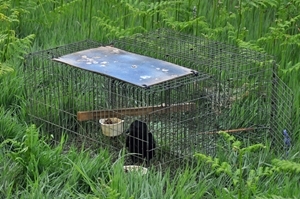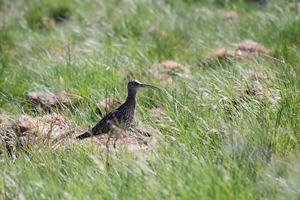 The Game & Wildlife Conservation Trust Cymru welcomes the opportunity to respond to this petition. We believe that control of members of the crow family (corvids) is crucially important to the conservation of many wildlife species within Wales, and that the use of Larsen traps is a vital component of this control. A recent study in Scotland commissioned by SNH (Commissioned Report No 931) showed that there were several distinct groups of people who considered it important to control corvid birds under the General Licences. Of the two lawful options (trapping and shooting), trapping is the more efficient means of control, and for conservation issues the most seasonally focused. The SNH study was extremely thorough, and the Welsh Government would be well advised to consider its evidence carefully.
The Game & Wildlife Conservation Trust Cymru welcomes the opportunity to respond to this petition. We believe that control of members of the crow family (corvids) is crucially important to the conservation of many wildlife species within Wales, and that the use of Larsen traps is a vital component of this control. A recent study in Scotland commissioned by SNH (Commissioned Report No 931) showed that there were several distinct groups of people who considered it important to control corvid birds under the General Licences. Of the two lawful options (trapping and shooting), trapping is the more efficient means of control, and for conservation issues the most seasonally focused. The SNH study was extremely thorough, and the Welsh Government would be well advised to consider its evidence carefully.
Selectivity of corvid trapping
Corvid trapping in general was found by the SNH study (Part 2) to be highly target-specific, with less than 3% of captures being non-target birds or mammals. Of the non-target birds, the most frequent captures were pheasants (1% of 4,500 captures) and buzzards (0.5%), and these were caught by a small minority of trappers (respectively 3% and 4%). Domestic cats and foxes formed 0.3% of captures. Larsen traps were the most commonly used trap.
Larsen traps
Larsen traps are designed specifically to use a live call bird rather than food bait and are used primarily to target crows and magpies. They rely on the territorial behaviour of these two species for their effectiveness. The live call bird appears as an intruder to territory-holding birds, which try to evict it, getting themselves caught in the process. The Larsen trap was introduced to the UK by the GWCT from Denmark in the 1980s, and our early research showed that live call birds are critical to success. Live callers increase the catch rate by 12 to 15 times; without them catch rates to traps with bait alone are so low as to be largely ineffectual. These trials produced a non-target catch rate of only 1% during the capture of over 10,000 crows and magpies1,2. Thus the use of a decoy bird, combined with the easy transportability and relatively low cost of the Larsen trap, create a highly selective technique, which can be deployed quickly in spring to prevent breeding by territory-holding corvids.
Reasons for controlling corvid birds in a conservation context
 Teasing out the impact of individual predators in a complex system is very difficult, and there have been very few studies of the effect of crows or magpies alone. However, the GWCT has carried out comprehensive studies of the impact of predation control by gamekeepers on a range of prey species. During the 1980s, the GWCT ran a predator removal experiment on Salisbury Plain, which included the control of crows and magpies. This showed a dramatic impact on the wild grey partridges, resulting in an average 3.5-fold increase in autumn population over three years, and a 2.5-fold increase in breeding pairs over the same period.
Teasing out the impact of individual predators in a complex system is very difficult, and there have been very few studies of the effect of crows or magpies alone. However, the GWCT has carried out comprehensive studies of the impact of predation control by gamekeepers on a range of prey species. During the 1980s, the GWCT ran a predator removal experiment on Salisbury Plain, which included the control of crows and magpies. This showed a dramatic impact on the wild grey partridges, resulting in an average 3.5-fold increase in autumn population over three years, and a 2.5-fold increase in breeding pairs over the same period.
More recently, the GWCT’s Upland Predation Experiment, carried out between 2000 and 2008, showed a trebling of breeding success by moorland breeding wading birds (curlew, lapwing, golden plover), where a gamekeeper was actively controlling predators, including crows. This study also showed a doubling of breeding success by red grouse, and a six times increase by black grouse. These moorland species are all seriously threatened in Wales, and the GWCT is of the view that crow and magpie control using Larsen traps is crucial to their conservation and recovery.
Animal welfare
Petition P-05-813 makes much of the supposed suffering of birds through being trapped day and night for long periods without food, water and shelter. Yet, as the petitioners also acknowledge, the terms of the General Licences allowing Larsen traps require the provision of adequate food, water at all times, appropriate shelter and a perch for decoy birds. As pointed out in the licences, users must also comply with all relevant provisions of the Animal Welfare Act 2006. This means that any action, or failure to act, causing unnecessary suffering would be a prosecutable offence. The Animal Welfare Act also extends to humane killing of trapped birds.
If crows have been “left to die without food and water” as the petitioners suggest, then the police should be involved, and the culprits should be prosecuted. Concerned about accusations of this type, and other issues related to the use of corvid cage trap use, Scottish Natural Heritage commissioned an investigation and report. This showed that the large majority of decoy birds examined in a field survey were in good or very good condition, indicating that trap users in Scotland take the welfare of their decoy birds seriously. Aside from any moral and legal obligation to decoys, trap users have the incentive that a fit, active and well-kept decoy is far more likely to do its job well.
Petition P-05-813 (Additional information) also claims that trapping continues throughout the summer, and that in consequence “thousands of chicks starve”. The GWCT believes that this issue is being exaggerated. In practice, Larsen trapping is more a spring than a summertime activity, and most users will set their traps when the crows and magpies become territorial in spring, well before the first crow and magpie eggs are laid. The trapping then continues through the nesting season, as this is key time for successfully reducing predation on nesting birds. However, it is important to note that the new colonists that move into territories where crows or magpies have been trapped will mostly be non-breeders that are looking for a territory. Having no territory, these birds will not have started a breeding attempt before they arrive, and will usually be caught in a matter of days, long before they have had time to start to nest. Meanwhile, territory holders with dependant young in neighbouring areas will not attempt to colonise vacant territories of which they have no need.
Misuse and abuse
Petition P-05-813 includes illegal use in its call for a ban on Larsen traps, citing baiting with live pigeons to trap birds of prey. The GWCT is aware of some instances of illegal use, and there has been at least one successful prosecution for targeting birds of prey. Making this doubly illegal by banning Larsen traps is hardly likely to make any difference: those intent on breaking the law over bird of prey protection will not take heed of a ban on the use of Larsen traps. This would simply make the lawful control of crows and magpies much more difficult for law-abiding citizens, and at the same time force the use of methods, such as baited cage traps, which would be less target-specific.
Other observations
The 1,943 petition signatories can be broken down by location as follows:
- Wales 37%
- England, Scotland and Northern Ireland 60%
- Other European countries 1%
- Other parts of the world 2%
The petition clearly cannot be considered even largely Welsh, nor to indicate a view that is widely held in Wales. We question whether the 63% of signatories from other countries can have any direct knowledge of how Larsen traps are used in Wales, or of the reasons for corvid control in Wales, or any rightful say in Welsh affairs.
We would ask that the Welsh Assembly carry out research into the genuine responses of the Welsh public who have adequate information about the reason why Larsen traps are used and how this is done under strict legal conditions and within a Code of Good Practice. Our experience would suggest that these 1,943 signatories from all over the world are a very small, idealistic group that is not at all representative of the Welsh public.
In our collaborative work with the Powys Moorland Project, we invite groups of 60 or 70 members of the public to a workshop on management activities on the moors. We find that their opinions of predation control change through the two-hour meeting. Many people arrive at our meetings with strong pre-conceived ideas opposing any form of predation control through trapping or killing of predators. Once we explain the purpose and outcomes of predation control and how it is carried out within the Code of Good Practice, there is a great shift in their opinion towards supporting this action into the future. This is particularly the case when speaking about the use of Larsen traps as part of suite of management measures in saving threatened species such as the curlew.
References
1 Reynolds, J.C. (1990). Crow and magpie control: the use of call birds in cage traps. The Game Conservancy Review 21: 48 -49.
2 Tapper, S.C., Swan, M.C. & Reynolds, J.C. (1991). Larsen traps: a survey of members’ results. The Game Conservancy Review 22: 82-86